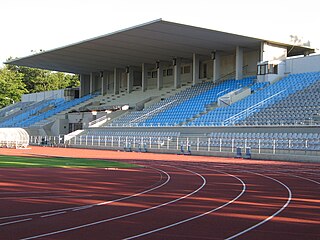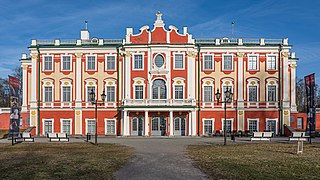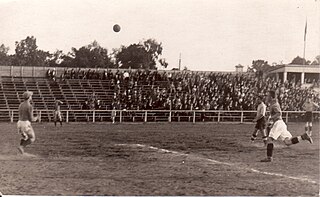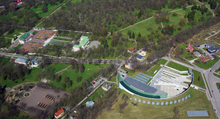
Tallinn is the capital, the primate and most populous city of Estonia. Situated on a bay in north Estonia, on the shore of the Gulf of Finland of the Baltic Sea, Tallinn has a population of about 457,000 and administratively lies in the Harju maakond (county). Tallinn is the main governmental, financial, industrial, and cultural centre of Estonia. It is located 187 km (116 mi) northwest of the country's second largest city, Tartu; however, only 80 km (50 mi) south of Helsinki, Finland, also 320 km (200 mi) west of Saint Petersburg, Russia, 300 km (190 mi) north of Riga, Latvia, and 380 km (240 mi) east of Stockholm, Sweden. From the 13th century until the first half of the 20th century, Tallinn was known in most of the world by variants of its other historical name Reval.

Kadriorg Stadium is a multi-purpose stadium in Tallinn, Estonia. Opened in 1926, it is one of the oldest stadiums in Estonia. It is currently used mostly for track and field competitions, but also serves as a home ground for JK Tallinna Kalev. The stadium holds 5,000. Kadriorg Stadium is located about 2 km east of the city centre in the subdistrict of Kadriorg near Kadriorg Palace. The address of the stadium is Roheline aas 24, 10150 Tallinn.

The Kopli cemetery was Estonia's largest Lutheran Baltic German cemetery, located in the suburb of Kopli in Tallinn. It contained thousands of graves of prominent citizens of Tallinn and stood from 1774 to shortly after World War II, when it was completely flattened and destroyed by the Soviet occupation authorities governing the country at the time. The former cemetery is now a public park.

Kesklinn is one of the 8 administrative districts of Tallinn, the capital of Estonia. It is situated on the Tallinn Bay and bordered to the northwest by the district of Põhja-Tallinn, to the west by Kristiine, to the southwest by Nõmme, to the east by Lasnamäe and Pirita, and to the south by Rae Parish, beyond Lake Ülemiste. The island of Aegna, located in the Tallinn Bay, also falls within this administrative district. Kesklinn has an area of 30.6 km2 (11.8 sq mi) and a population of 57,731 ; population density is 1,886.6/km2 (4,886/sq mi).
The Kalamaja cemetery, in Tallinn in Estonia was once the city's oldest existing cemetery, located in the suburb of Kalamaja in the north of the city. It contained thousands of graves of ethnic Estonian and Swedish residents of Tallinn and stood for at least 400 years, from the 15th or 16th century to 1964 when it was completely flattened and destroyed by the Soviet occupation authorities governing the country at that time. The former cemetery is now a public park: "Kalamaja kalmistupark".

Kalamaja is a subdistrict of the district of Põhja-Tallinn in Tallinn, the capital of Estonia. It is located just northwest of the historical town centre, on the coast of the Tallinn Bay. Kalamaja has a population of 9,820.

The Tallinn Song Festival Grounds are the grounds on which the Estonian Song Festival "Laulupidu" is held every five years.

Hiiu Stadium is a football stadium in Tallinn, Estonia. Opened in 1936, it is the home ground of Nõmme Kalju FC. The stadium is located about 8 km southwest of the city centre, in the district of Nõmme. The address of the stadium is Pidu tänav 11, Tallinn.

Russalka Memorial is a bronze monument sculpted by Amandus Adamson, erected on 7 September 1902 in Kadriorg, Tallinn, Estonia to mark the ninth anniversary of the sinking of the Russian warship Rusalka, or "Mermaid", which sank en route to Finland in 1893. It was the first monument in Estonia made by an Estonian sculptor. The monument depicts an angel holding an Orthodox cross towards the assumed direction of the shipwreck. The model for the angel was the sculptor's housekeeper.

Karjamaa is a subdistrict in the district of Põhja-Tallinn, Tallinn, the capital of Estonia. It's located northwest of Kalamaja and east of Sitsi, main part is between Kopli, Tööstuse and Erika streets. Karjamaa also includes the Hundipea area and the Mine Harbour (Miinisadam) by the Tallinn Bay. Karjamaa has a population of 5,314.
The Art Museum of Estonia was established in 1919. Originally based in Kadriorg Palace, the museum has expanded across several sites and today exhibits both international and local art works. At the end of the 1970s, in the 1980s the first branches of the Art Museum of Estonia were founded. Starting in 1995, all of the branches offer different educational programmes for children and young people. In 1996, the exhibition hall on the first floor of Rotermann Salt Storage was opened; this branch was closed in May 2005.

Maarjamäe is a subdistrict in the district of Pirita, Tallinn, the capital of Estonia. It is bordered by Pirita and Kose to the north, Lasnamäe to the south, Kadriorg to the southwest and the Bay of Tallinn to the west. As of 2022, it has a population of 2,412.

Kadriorg is a subdistrict in the district of Kesklinn ("Midtown"), Tallinn, the capital of Estonia. It has a population of 4,561. The subdistrict name derives from the Catherinethal, a Baroque palace of Catherine I of Russia. It is one of the wealthiest neighbourhoods in Estonia.

Kadriorg Palace is an 18th-century Petrine Baroque palace in Kadriorg, Tallinn, the capital of Estonia. Both the Estonian and the German name for the palace means "Catherine's valley". It was built in 1718–1725 to Nicola Michetti's designs by Gaetano Chiaveri and Mikhail Zemtsov. The palace currently houses the Kadriorg Art Museum, a branch of the Art Museum of Estonia, displaying foreign art from the 16th to 20th centuries. The building of the Kumu branch of the museum, showing Estonian art from the 18th century onwards is located nearby in the Kadriorg Park.

The Estonian Knighthood House is a building in Toompea, the upper part of Vanalinn, the historic inner town of Tallinn, the capital of Estonia. Its address is Kiriku plats 1. The Dome Church is situated at the same square.
The men's 110 metres hurdles event at the 2015 European Athletics U23 Championships was held in Tallinn, Estonia, at Kadriorg Stadium on 10 and 11 July.
The women's 400 metres event at the 2015 European Athletics U23 Championships was held in Tallinn, Estonia, at Kadriorg Stadium on 9 and 11 July.
The women's hammer throw event at the 2015 European Athletics U23 Championships was held in Tallinn, Estonia, at Kadriorg Stadium on 10 and 11 July.

The Residence of the President of Estonia, known officially as the Kadriorg Administrative Building, and since 1992 sometimes colloquially as the "president's palace", is a building located in the Kadriorg Park, Tallinn, capital city of Estonia. The Baroque Revival building serves as the official residence of the president of Estonia.

TJK Stadium, also known as TJK jalgpalliväli, was a football stadium in Tallinn, Estonia, and the home of TJK. Opened in 1925, its wooden grandstand could seat 3,740 and with its additional standing capacity of 6,000, the stadium was able to facilitate nearly 10,000 spectators. The stadium was located in the subdistrict of Kadriorg near the Kadriorg beach and the Tallinn Harbour. Today, the site of the former stadium is occupied by Kadriorg's Business Center and Liivaoja apartment buildings.















